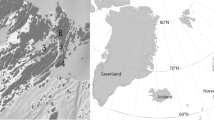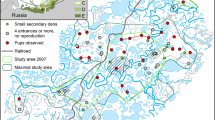Abstract
The American mink Neovison vison is an invasive carnivore which may significantly affect populations of the water vole Arvicola amphibius. However, its impact on this rodent species depends on the abundance, dispersion and configuration of the habitats suitable for water voles and their accessibility for the mink. Using live-trapping, we studied the water vole and American mink populations inhabiting midfield ponds located in the vicinity of a large lake. In the same area, the mink diet was described after collecting and analysing scats. During four spring seasons, the water vole density gradually increased and no population peaks or crashes were observed. The maximum recorded density was 9.0 individuals/1 km of pond shoreline. Water voles displayed high year-to-year population turnover: less than 5% of the marked individuals were recaptured in the following year. In April-July, the exchange of individuals in the population during one-month periods was also high and usually exceeded 50%. Water vole remains were found in mink scats in all seasons, and the highest overall percentage biomass of water vole in mink diet for a two-months period reached 52.2% in May-June 2012. The results of our study show that at small water bodies adjacent to a large lake, the water vole population may withstand the impact of the invasive American mink.
Similar content being viewed by others
References
Aars, J., Lambin, X., Denny, R., Griffin, A., 2001. Water vole in the Scottish uplands: distribution patterns of disturbed and pristine populations ahead and behind the American mink invasion front. Anim. Conserv. 4, 187–194.
Andreassen, H.P., Ims, R.A., 2001. Dispersal in patchy vole populations: role of patch configuration, density dependence, and demography. Ecology 82, 2911–2926.
Barreto, G.R., Macdonald, D.W., 2000. The decline and local extinction of a population of water voles, Arvicola terrestris, in Southern England. Z. Saugetierkd. 65, 11–120.
Barreto, G.R., Macdonald, D.W., Strachan, R., 1998a. The tightrope hypothesis: an explanation for the plummeting water vole numbers in the Thames catchment. In: Bailey, R.G., Jose, P.V., Sherwood, B.R. (Eds.), United Kingdom Floodplains. The Linn. Soc, London, pp. 311–327.
Barreto, G.R., Rushton, S.P., Strachan, R., Macdonald, D.W., 1998b. The role of habitat and mink predation in determining the status and distribution of declining populations of water voles in England. Anim. Conserv. 1, 129–137.
Barton, K., Available at: 2015. MuMIn: Multi-Model Inference (R Package Version 1.15.1) (Accessed 31 May 2017) https://doi.org/CRAN.R-project.org/package=MuMIn.
Bartoszewicz, M., Zalewski, A., 2003. American mink, Mustela vison, diet and predation on waterfowl in the Słonsk Reserve, western Poland. Folia Zool. (Brno) 52, 225–238.
Bates, D., Maechler, M., Bolker, B., Walker, S., 2015. Fitting linear mixed-effects models using lme4. J. Stat. Softw. 67 (1), 1–48.
Brzezinski, M., 2008. Food habits of the American mink Mustela vison in the Mazurian Lakeland, northeastern Poland. Mamm. Biol. 73, 177–188.
Brzezinski, M., Marzec, M., 2003. Correction factors used for estimating prey biomass in the diet of American mink Mustela vison. Acta Theriol. 48, 247–254.
Brzezinski, M., Romanowski, J., Zmihorski, M., Karpowicz, K., 2010. Muskrat (Ondatra zibethicus) decline after expansion of American mink (Neovison vison) in Poland. Eur.J. Wildl. Res. 56, 341–348.
Brzezinski, M., Ignatiuk, P., Zmihorski, M., Zalewski, A., 2018. An invasive predator affects habitat use by native prey: American mink and water vole co-existence in riparian habitats. J. Zool. 304, 109–116.
Burnham, K.P., Anderson, D.R., 2002. Model Selection and Multi-Model Inference: A Practical Information-Theoretic Approach. Springer, New York, USA.
Carter, S.P., Bright, P.W., 2003. Reedbeds as refuges for water voles (Arvicola terrestris) from predation by introduced mink (Mustela vison). Biol. Conserv. 111, 371–376.
Centeno-Cuadros, A., Román, J., Delibes, M., Godoy, J.A., 2011. Prisoners in their habitat? Generalist dispersal by habitat specialists: a case study in Southern water vole (Arvicola sapidus). PLoS One 6, 1–11.
Cerqueira, D., De Sousa, B., Gabrion, C., Giraudoux, P., Quéré, J.P., Delattre, P., 2007. Cyclic changes in the population structure and reproductive pattern of the water vole, Arvicola terrestris Linnaeus, 1758. Mamm. Biol. 71, 193–202.
Craik, C., 1997. Long-term effects of North American Mink Mustela visonon seabirds in western Scotland. Bird Study 44, 303–309.
Ferreras, P., Macdonald, D.W., 1999. The impact of American mink Mustela vison on water birds in the upper Thames. J. Appl. Ecol. 36, 701–708.
Forman, D.W., 2005. An assessment of the local impact of native predators on an established population of British water voles (Arvicola terrestris). J. Zool. (Lond.) 266, 221–226.
Halliwell, E.C., Macdonald, D.W., 1996. American mink Mustela vison in the upper Thames catchment: relationship with selected prey species and den availability. Biol. Conserv. 76, 51–56.
Jędrzejewska, B., Sidorovich, V.E., Pikulik, M.M., Jędrzejewski, W., 2001. Feeding habits of the otter and the American mink in Białowieza Primeval Forest (Poland) compared to other Eurasian populations. Ecography 24, 165–180.
Kondracki, J., 1998. Geografia regionalna Polski. Wydawnictwo Naukowe PWN [in Polish].
Krawczyk, A.J., Bogdziewicz, M., Czyz, M.J., 2013. Diet of the American mink Neovison vison in an agricultural landscape in western Poland. Folia Zool. (Brno) 62, 303–309.
Lawton, J., Woodroffe, G., 1991. Habitat and distribution of water voles: why are there gaps in a species’ range? J. Anim. Ecol. 60, 79–91.
Macdonald, D.W., Sidorovich, V.E., Anisomova, E.I., Sidorovich, N.V., Johnson, P.J., 2002. The impact of American mink Mustela vison and European mink Mustela lutreola on water voles in Belarus. Ecography 25, 295–302.
MacPherson, J.L., Bright, P.W., 2010. Movements of radio-tracked American mink (Neovison vison) in extensive wetland in the UK, and the implications for threatened prey species such the water vole (Arviclola apmhibius). Eur.J. Wildl. Res. 56, 855–859.
MacPherson, J.L., Bright, P.W., 2011. Metapopulation dynamics and a landscape approach to conservation of lowland water vole (Arvicola amphibius). Landsc. Ecol. 26, 1395–1404.
Moorhouse, T.P., Macdonald, D.W., 2008. What limits male range sizes at different population densities? Evidence from three populations of water voles. J. Zool. Lond. 274, 395–402.
Nordström, M., Korpimäki, E., 2004. Effect of island isolation and feral mink removal on bird communities on small islands in the Baltic Sea. J Anim. Ecol. 73, 424–433.
Nordström, M., Högmander, J., Nummelin, J., Laine, J., Laanetu, N., Korpimäki, E., 2002. Variable responses of waterfowl breeding populations to long-term removal of introduced American mink. Ecography 25, 385–394.
Ousterhout, B.H., Semlitsch, R.D., 2014. Measuring terrestrial movement behavior using passive integrated transponder (PIT) tags: effects of tag size on detection, movement, survival, and growth. Behav. Ecol. Sociobiol. 68, 343–350.
Potapov, M.A., Rogov, V.G., Ovchinnikova, L.E., Muzyka, V.Y., Potapova, O.F., Bragin, A.V., Evsikov, V.I., 2004. The effect of winter food stores on body mass and winter survival of water voles, Arvicola terrestris, in Western Siberia: the implications for population dynamics. Folia Zool. 53, 37–46.
Qgis Development Team, 2014. QGIS Geographic Information System. Open Source Geospatial Foundation Project (Accessed 31 May 2017) https://doi.org/www.qgis.org/.
RCore Team, 2016. R: A Language and Environment for Statistical Computing. R Foundation for Statistical Computing, Vienna, Austria (Accessed 31 May 2017) https://doi.org/www.R-project.org/.
Rushton, S.P., Barreto, G.W., Cormack, R.M., Macdonald, D.W., Fuller, R., 2000. Modelling the effects of mink and habitat fragmentation on the water vole. J. Appl. Ecol. 37, 475–490.
Sidorovich, V.E., Polozov, A.G., Zalewski, A., 2010. Food niche variation of European and American mink during the American mink invasion in north-eastern Belarus. Biol. Invasions 12, 2207–2217.
Stoddart, D.M., 1970. Individual range, dispersion and dispersal in a population of water voles (Arvicola terrestris (L.)). J. Anim. Ecol. 39, 403–425.
Stoddart, D.M., 1971. Breeding and survival in a population of water voles. J. Anim. Ecol. 40, 487–494.
Strachan, R., Moorhouse, T., Gelling, M., 2011. Water Vole Conservation Handbook, 3rd edn. Wildlife Conservation Research Unit, Great Britain.
Telfer, S., Holt, A., Donaldson, R., Lambin, X., 2001. Metapopulation processes and persistence in remnant water vole populations. Oikos 95, 31–42.
Telfer, S., Piertney, S.B., Dallas, J.F., Stewart, W.A., Marshall, F., Gow, J.L., Lambin, X., 2003. Parentage assignment detects frequent and large-scale dispersal in watervoles. Mol. Ecol. 12, 1939–1949.
Weber, J.-M., Aubry, S., Ferrari, N., Fischer, C., Lachat Feller, N., Meia, J.-S., Meyer, S., 2002. Population changes of different predators during a watervole cycle in a central European mountainous habitat. Ecography 25, 95–101.
Woodroffe, G.L., Lawton, J.H., Davidson, W.L., 1990. The impact of feral mink Mustela vison on water voles Arvicola terrestris in the North Yorkshire Moors National Park. Biol. Conserv. 51, 49–62.
Author information
Authors and Affiliations
Corresponding author
Rights and permissions
About this article
Cite this article
Brzeziński, M., Chibowska, P., Zalewski, A. et al. Water vole Arvicola amphibius population under the impact of the American mink Neovison vison: Are small midfield ponds safe refuges against this invasive predator?. Mamm Biol 93, 182–188 (2018). https://doi.org/10.1016/j.mambio.2018.06.002
Received:
Accepted:
Published:
Issue Date:
DOI: https://doi.org/10.1016/j.mambio.2018.06.002




